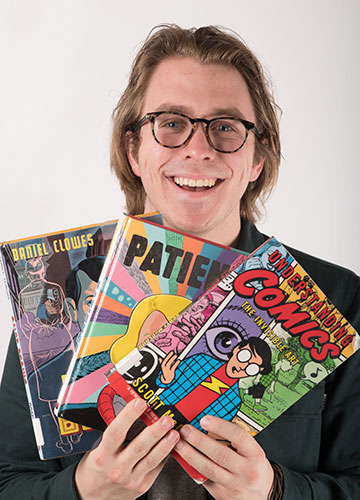
Graphic novels that break the fourth wall

What are you going to do for your I.S.?
It’s the question every rising Wooster senior faces, and a lot rides on the answer. It has to be a topic of some significance, of course, engaging enough to work on for almost seven months, and sufficiently well-defined that it can be completed in that time. If you are a student with multiple interests, that needle can be even harder to thread. Harry Todd, an English major and film studies minor, found the perfect bridge between the two in a close reading and analysis of the graphic novels of Daniel Clowes.
“I’ve always been interested in the visual storytelling of films,” Harry says, “and I grew up reading alternative comics.” Back home last summer after a semester-long program in Denmark focused on film and art, he happened to pick up a copy of Patience, a graphic novel by Daniel Clowes. He read it, and immediately went back to the library for more. The main character in the next novel he checked out, David Boring, wants to be a film maker. Harry was hooked.
Clowes is an important figure in the graphic novel world – his best-known work, Ghost World, was made into a film starring the 17-year-old Scarlett Johansson in 2001 and nominated for an Oscar – but not much scholarship has been done on him, or indeed on the entire medium of graphic novels. Harry decided to focus on a metafictional analysis of Clowes’ work.
Metafiction is fiction that is self-aware and comments on itself. Just as the actors in a play or film will “break the fourth wall” – think Frank Underwood in House of Cards suddenly turning toward the camera and offering the viewer an aside on the action – metafiction draws the reader in to think more deeply about the work on multiple levels.
“Clowes’ graphic novels are aware and actively comment on what a graphic novel is or should be,” Harry says. “He plays games with the reader, referencing other works of his that the characters in the novel would have no understanding of, blending elements of his own autobiography with the role of any father character. Visually, he’s much more subtle than other graphic novelists in how he both works within the conventions of 1950s- and 1960s-style comics, and then self-consciously breaks them.”
While the term metafiction is of relatively recent coinage, notes Professor Debra Shostak, Harry’s I.S. advisor, the concept itself “has a long and honorable tradition” from Tristram Shandy and Joyce’s Ulysses, to Toni Morrison’s Beloved and the short fiction of Donald Barthelme.
“A lot of Harry’s interest in the graphic novel form comes from the way he has learned to think about narrative form in film,” Shostak says. The graphic novel medium “is really exploding. It’s been a real education for me to be thinking about the form with him.”
Through his detailed analysis of both words and images, Harry reveals the multiple layers of Clowes’ work, and a more active role for the reader. “Conventional wisdom suggests that all power is in the hands of the author, the creator of a work of fiction,” he says, “and at times, that certainly seems so. But sometimes the power shifts to the reader who recognizes the metafictional elements. Becoming aware of those elements empowers the reader to understand the form and medium on a deeper level.”
Posted in Independent Study on September 19, 2018.
Related Posts
Related Areas of Study
English
Students benefit from the small classes and access to faculty members in the small private liberal arts setting at Wooster.
Major Minor

